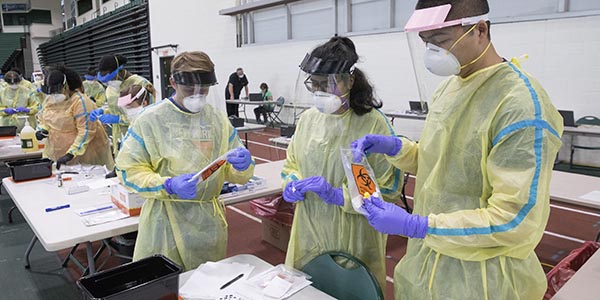Quarantine? Isolation? How to prepare

As surveillance and diagnostic testing continue at Binghamton University, positive cases remain low with an overall 0.61% positive test percentage to date. But what happens when a student is notified of the need to quarantine — or isolate?
By necessity, the process happens fast, according to Beth Riley, assistant dean of students and director of Case Management Services, so it would be helpful if students prepare ahead of time.
Because no individual can know if they will need to isolate or quarantine, students are encouraged to plan ahead, Riley said. “It’s kind of like when a pregnant woman packs a bag to be ready to go to the hospital. We hope students will be ready in case they have to isolate or quarantine — have some favorite snacks ready, keep up with laundry, have a plan.
“It’s not unlikely that a student could have a quarantine experience this semester,” Riley added.
“Affected students are initially contacted by a medical professional who explains that they have been identified for isolation or quarantine,” Riley said. “After that, a lot happens quickly.”
Whether they are to isolate for 10 days or quarantine for 14 days, on-campus students are given two options to consider, said Cait Crisman, with the University’s Office of Emergency Management, who oversees the on-campus isolation and quarantine housing efforts. “The first option — and the one we encourage students to choose if they can — is to return home or spend their quarantine or isolation at an off-campus location. The second option for on-campus students is to stay in our campus isolation/quarantine housing if there is a medical reason they cannot go home.”
Off-campus students choose between returning home or isolating/quarantining in their off-campus apartment.
“We know it can be overwhelming to these students to upend their lives so fast, but we do try to give them as much information as possible about next steps so they know what to expect no matter where they choose to isolate or quarantine,” Riley said. “We are also often in touch with parents in these cases.”
The students’ arrangements need to be made no later than 8 p.m. the day they are notified — sooner if possible. If students who choose to leave campus cannot vacate their on-campus housing by 8 p.m., they’ll be moved to the isolation/quarantine housing until they can leave the following day. Students who choose to remain on campus must move to the isolation/quarantine housing by 8 p.m.
“We try to reduce the number of short-term moves, so we sometimes find ourselves making exceptions on a case-by-case basis if a student needs a little extra time to vacate a room,” Crisman said. “Our ultimate goal is to move students as quickly and as safely as possible.
“We also provide the students information on what to pack for their move,” Crisman said. “And we provide them a Care Kit with some of the essential things they’ll need, like a thermometer and cleaning products.”
“We also try to help them understand the importance of obeying all of the guidelines they are subjected to, even though we know it’s hard on them,” she added.
The move, however, must be done by the students themselves, similar to when they moved into on-campus housing in August. Residential Life provides green laundry carts to assist, but no friends or family can help with the move.
While students are isolated or quarantined, University staff and the Broome County Health Department check in on them regularly. Students who return home are monitored by their county health department.
Students are also provided with information on resources they can tap, including how to notify the Registrar’s Office that they will be switching to totally remote learning.
“They also have the support of the CARE Team, the University Counseling Center and their academic advising offices,” Riley said.
Once the isolation or quarantine period is over, students don’t require a negative test before they return to campus, but they must be officially released by their county health department and/or be notified by the University’s medical director that their isolation/quarantine period is over before they can return to their regular housing.
